Working on the railroad
April 25, 2013
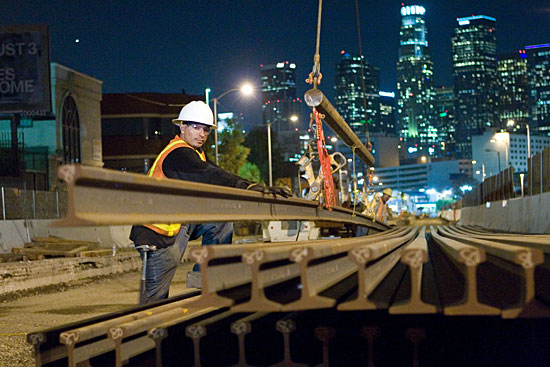
All the new rail Metro is laying means more job opportunities in maintenance and operations. Photo courtesy Metro
With soaring tuition costs and an economy recovering at a glacial pace, it’s a tough time to pursue a career. But Los Angeles County Metropolitan Transportation Authority is in the midst of a vast expansion of its rail network and will need skilled hands to take care of such work as maintenance, inspection and communications.
With that approaching reality in mind, Metro’s Board of Directors on Thursday approved the Rail Technical Training Program, a new collaboration between the transportation agency and Los Angeles Trade Technical College.
“For young people who aren’t interested in a four-year school, this could be an opportunity to get hands-on training and learn something specific to the transportation industry,” said Marion Jane Colston, director of strategic and organizational planning for the agency.
Metro will provide technology and on-the-job expertise while the college adds the academic piece. Together, they hope to create a cutting-edge program to train existing employees and give a new generation of workers the skills they’ll need to land jobs at Metro or other rail operators.
After the program is approved, staff from both sides will develop a standardized curriculum, which will be presented to the California Community Colleges Chancellor’s Office for review. If approved, the college will then be able to offer a new trade certificate and students can apply for financial aid to take the classes.
Leticia Barajas, the trade school’s vice president of instruction, sees great potential in the program.
“Our goal is to become the premier training institution for Metro,” Barajas said. “Students seeking this certification could also get their associates degree and move on further.”
In the future, she added, the school hopes to train students for management positions to give them another path to career advancement.
For Metro, the program is a way to make sure its staff has the best training possible to keep trains moving swiftly and safely, while preparing to meet a looming need for additional skilled workers.
“For every mile we add, we’ll need to increase the staff by a similar proportion,” said Bruce Shelburne, Metro’s executive director for rail operations.
When the projects from the Measure R sales tax are built, the amount of rail will have roughly doubled, so the number of workers will need to double, too.
For Barajas, that sounds like a bright future for her students. “It’s an amazing opportunity to get into high paying jobs with real opportunity for career advancement in the L.A. region.”
Posted 4/25/13
Winning Universal raves
April 23, 2013
Universal City is one of L.A.’s most famous destinations. It is also a member of a famously complex community.
Part movie studio, part theme park, part corporate campus, part international tourist attraction, the 391-acre site—which lies both in the city and county of Los Angeles—plays almost as many roles as the entertainers who work there.
Its operations impact millions of Southern Californians, from workers and shareholders to homeowners and commuters. No wonder, then, that when NBCUniversal began talking about a master plan for the property, and then about a major expansion, it took more than seven years for all the stakeholders to reach the consensus that came before the Board of Supervisors this week.
NBCUniversal’s Evolution Plan, endorsed unanimously on Tuesday by the Board of Supervisors, is a big deal. And that’s not just because the $1.6 billion final product promises to create more than 30,000 jobs while expanding production facilities and bringing “The Wizarding World of Harry Potter” to L.A.
With a new trailhead park and a nearly $14 million investment in the L.A. River Bike Path, it jumpstarts the riverfront’s revitalization. It paves the way—literally—for a long-dreamed-of bike route from the San Fernando Valley to Long Beach.
Its $100 million in transit improvements will ease congestion in the long-suffering southeast San Fernando Valley even as NBCUniversal adds 1.88 million square feet of net new space for studios, offices, tourism and entertainment. Overall, the project is expected to generate some $2 billion in economic output, and add $15 million in new tax revenues to the county annually.
Talk about a stimulus package. And we can expect it to pay dividends for generations to come.
But what impressed me most was that at a time when all the talk is about how impossible our politics are as a nation, this was a case study in democracy with a “small d”. Projects of this magnitude often leave communities feeling railroaded and businesses feeling thwarted. Negatives are forced on one side or another in the name of progress, or as a necessary cost of doing business.
But on details big and small, NBCUniversal and its community collaborated to make this plan work for all sides.
When some—myself included—balked at the idea of replacing a large chunk of crucial backlot with 3,000 apartments and condos, the company scrapped the housing and doubled down on its core entertainment business. When potential glare from office lights posed a concern to homeowners, NBCUniversal agreed to 10 p.m. lights-out in unoccupied offices in key buildings.
Digital signage was dramatically scaled back, and neighbors’ views were protected with new landscaping. Perhaps most significantly, the plan establishes a community advisory panel to maintain the partnership on a regular basis.
Working together in a place with this many moving parts isn’t always easy. And compromise is famous for happening away from the limelight.
But when it does happen, it’s almost as thrilling as the words, “Lights! Camera! Action!” There was applause this week as the Board approved this project, and I suspect that the way it came together will be winning raves for a long, long time.
Posted 4/23/13
Of broomsticks and bikes
April 23, 2013
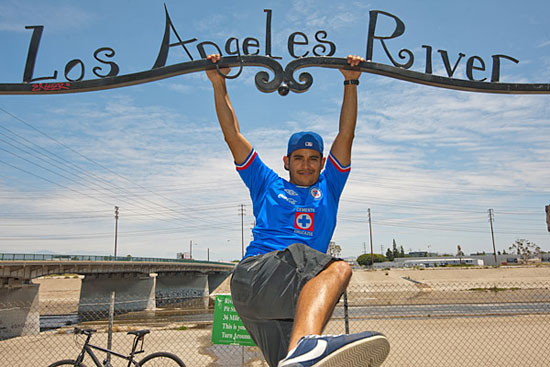
Thanks to a multi-million dollar infusion from NBCUniversal, L.A. River cyclists have something to cheer about.
With a promise of transforming Los Angeles tourism, The Wizarding World of Harry Potter is coming to Universal Studios as part of the company’s $1.6 billion expansion of its theme park and backlot. But there’s another attraction coming, too—with a constituency as fanatical as any Hogwarts crowd.
In a deal pushed and brokered by Los Angeles County Supervisor Zev Yaroslavsky, NBCUniversal has agreed to put $13.5 million into an effort to revitalize the Los Angeles River and complete a miles-long stretch of the river bikeway. And while the price-tag may seem small compared to the giant numbers behind the Potter venture and backlot expansion, it promises to be just as transformative in the worlds of alternative transportation and river restoration.
“It’s huge,” said Eric Bruins, planning and policy director for the Los Angeles County Bicycle Coalition. The development of the Los Angeles River and bikeway, he said, “creates a place where families can go and step away from the city while still being close to home.”
The recreational and commuting potential of the existing Los Angeles River Bikeway has been undermined by a nearly 6.5 mile gap between Griffith Park and Studio City. In negotiating a development agreement with NBCUniversal, Yaroslavsky pushed the company to focus its “community benefits” efforts on completing that vital stretch of the bikeway—despite the entertainment conglomerate’s earlier resistance to the idea.
“This project presented a singular opportunity to ultimately create a seamless bikeway from Long Beach to the San Fernando Valley,” Yaroslavsky said Tuesday prior to the board’s unanimous endorsement of the company’s “evolution plan.” “A big gap in this dream was the segment adjacent to NBCUniversal. Both the county and NBCUniversal seized the opportunity to solve this problem. Thanks to all involved, we can now look forward to planning and constructing the next generation of bikeway for our region.”
NBCUniversal has agreed to provide Los Angeles County with funding to fully complete an initial leg of the bikeway between Griffith Park and Lankershim and Barham boulevards, near the Universal Studios backlot. The remaining amount of the $13.5 million would then be used for the planning, regulatory and construction needs for the remaining stretch to Whitsett Avenue in Studio City. The company also has agreed to build a nearly 1-acre trailhead park along the river.
Among the groups who’ve long pushed for the expanded bikeway was Friends of the Los Angeles River. Its founder and president, Lewis MacAdams, applauded NBCUniversal’s “unprecedented generosity.” The cooperation between Universal and the environmental community, he said, “has set a very high bar for the rest of the media companies that line the banks of the river’s ‘Studio Stretch’ in the years to come.”
The Los Angeles River Revitalization Corp. also was instrumental in the public-private coalition that led to the unprecedented funding by the studio, which has been located along the concrete-sided waterway since Hollywood’s earliest days of filmmaking. The non-profit organization’s executive director, Omar Brownson, called the proposed bikeway extension the “cornerstone for the connectivity for all 51 miles of the L.A. River.”
But just as important, he said, the entertainment company’s involvement also sends a powerful message about “how we see and invest in our river. For a long time, it was looked at as a liability. Now people are looking at it as an asset.”
Posted 4/23/13
Making tracks to the Westside
April 18, 2013
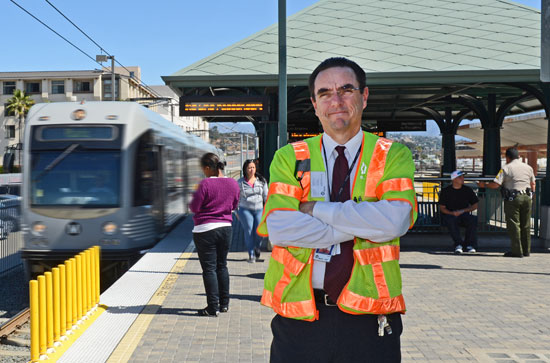
Metro's rail operations chief, Bruce Shelburne, says bike ridership on the trains has gone "sky high."
Bruce Shelburne is hoping for the best. But he’s bracing for “a learning experience.”
As Metro’s executive director for rail operations, Shelburne will have his hands full this Sunday, when the hugely popular CicLAvia winds its way for the first time from downtown Los Angeles to Venice, promising to pack the rail system with riders headed to points along the 15-mile route. At the same time, the Los Angeles Times Festival of Books and the Grand Prix of Long Beach will also be feeding crowds onto the rail lines.
Still, Shelburne, a 26-year Metro veteran, says he’s learned not to get overly stressed by the logistics and pitfalls of his job. “I’m learning to let go a little bit,” he says. “Otherwise you’re going to find yourself on the wrong end of a shovel, six-feet under.”
Shelburne expects one major CicLAvia hotspot to be the new Expo Line’s Culver City station, which, for now, is the closest stop to the sea. That end-of-the-line location will make it a major—and potentially clogged—entrance and exit point for people interested in traveling only along the route’s western end. Culver City’s elevated station might also complicate things because cyclists will have to carry bikes up and down stairs or crowd into elevators.
Increasing the potential congestion, CicLAvia has placed one of its “hubs” there to provide water, restrooms, and bike repairs, while Culver City and its businesses are planning a variety of entertainment options, including free massages and live music to complement food and shopping deals. A bike valet will help people make sure their wheels are secure while they browse the area.
Throughout Metro’s rapidly expanding rail system, Shelburne and his staff will also have to grapple with the reality that many CicLAvia passengers will be riding the rails for the first time and are unfamiliar with the agency’s TAP Card system, which can be confusing to the uninitiated.
“Trust me,” Shelburne says, “if that becomes a bottleneck, we’ll undo that real quick. We’ll address it with any means necessary to get people moving.”
Shelburne says that he sees CicLAvia and other major seam-stretching L.A. events as laboratories for lessons that can be applied in the future. For example, based on past CicLAvias, Shelburne says he’s doubling the number of trains on some lines. And while bikes are normally limited to two per train, Shelburne says, “we tend to look the other way on this kind of day.” In fact, Metro staffers will try to devote one car or maybe more per train to cyclists.
“It’s not all about the bikes,” Shelburne says. “We can’t take all the seats out. We have 100 million riders boarding the system annually and the majority of them don’t use bikes….The advantage is that bicyclists, especially the experienced ones, tend to work well with each other.”
(On Thursday, the regional rail service Metrolink announced it would be putting all 17 of its specially-outfitted “bike cars” into service on Sunday to serve the CicLAvia crowds. More information is here.)
While Shelburne is modest about his team’s successes managing past events, he’s particularly proud of one of his personal contributions—deploying Metro staffers to help people navigate the system and provide a human face to agency. Humor helps, too, he says. “If you’re not afraid to make a joke at your own expense, it goes a long way.”
On the future of bikes and trains in general, Shelburne sees a growing challenge and the need for a new relationship between cyclists and other passengers. “It seems like our bicycle ridership has really gone sky high,” he says.
Metro has already removed seats from older rail cars, and new cars will include additional accommodations for bicycles. But in the long term, Shelburne says, Metro will need to look at additional measures, such as arranging seats around the edges of cars to open more floor space.
While Shelburne admits he’s not one to jump on a bike very often, he does spend a plenty of time on the rails each day. He commutes from his home Oxnard to Union Station in downtown L.A.—a 70-mile trip that takes more than 90 minutes each way. On the way home, it’s a chance to catch up with work. But in the morning, he says, the smooth ride is the perfect opportunity for a pre-office nap.
“What rail buys,” he says, “is peace of mind and consistency. It just calms you down and you don’t have to worry about some of the idiots on the road.”
Venice welcomes CicLAvia—warily
April 18, 2013

A lone bike along the Venice boardwalk is certain to have plenty of company come Sunday's CicLAvia to the sea.
Danny Farahirad predicts Sunday’s CicLAvia will be “awesome.” The last time the cycling extravaganza took to the streets of Los Angeles, his family-owned Downtown L.A. Bicycles fixed more than 150 flat tires and rented about 40 bikes in a single day.
But Farahirad is in the central city, where the car-free event has been a rousing success for three years now. Less optimistic is Hyun Dong, who manages a t-shirt stand at the end of this weekend’s new route, on the Venice Boardwalk.
“Bicycles? Bad for business,” Dong sighs, mulling his customer-less shop from behind the cash register on a recent weekday. “Just like the events with the joggers. No one buys anything.”
As L.A.’s favorite car-free movable party ventures out of the city core on its first-ever push to the ocean from Downtown Los Angeles, a mixture of excitement and apprehension awaits on the city’s populous Westside. (Click here for a map.)
As many as 200,000 people are expected to participate in the event, which promises to be the biggest, longest CicLAvia so far; more than 15 miles of asphalt will close to motor vehicles from 10 a.m. to 3 p.m. to make way for a free-flowing crowd of cyclists, walkers, skaters, wheelchair riders, skateboarders and others.
Advance word of the event has been accompanied by high hopes that its street-fair atmosphere will continue to travel with it, but there also have been scattered concerns that it could deter sales and jam traffic in one of the densest areas of the city. Complicating the picture are lingering jitters from this week’s Boston Marathon bombing.
“There are nuts out there who are intent on hurting people,” worries Venice resident Linda Kadi, “and after what just happened, it’s scary to think about having a huge bunch of people here in one place.”
CicLAvia organizers say they expected Westside merchants and residents to need some reassurance, and that they have been doing outreach in the community for several months.
“It’s a new route,” says volunteer coordinator Martin Lopez-Iu of the Los Angeles County Bicycle Coalition. “We’ve never done this before, so some of the reactions have been kind of confused. When people in L.A. hear that you’re closing streets and taking away parking, it’s easy for them to think, ‘Oh, my God, you’re taking away business.’ But when people slow down, they’re actually more inclined to stop into their local coffee shop or restaurant.”
He notes that most communities are welcoming the excitement. For example, in Culver City, where the first phase of the new Expo Line ends, the Chamber of Commerce and Downtown Business Association have co-sponsored one of several “hubs” where participants can gather.
But at the end of Venice Boulevard, where the route empties into a parking lot abutting the Venice Boardwalk, shopkeepers predict that CicLAvia will draw foot traffic away from their wares on the weekend, when they make most of their sales.
“That’s gonna be a loss of fund-age, absolutely,” predicted a clerk selling glass pipes next to a marijuana dispensary who would identify himself only by his first name, Gary.
“And business has been slow already,” chimed in a neighboring jewelry merchant. “Even spring break came and went and I didn’t even notice. It was our worst spring break in 25 years.”
Lopez-Iu notes that Venice Boulevard is a popular attraction in its own right, and says CicLAvia organizers have worked with businesses before to overcome such worries. In 2011, for instance, merchants in the downtown garment and piñata districts complained that CicLAvia street closures would disrupt business on their busiest weekend day.
“Those guys do a lot of business on Sunday, and it requires people to come in in cars, and the first time we did the event there, they had a lot to say about it,” says Lopez-Iu. “So the next time, we worked with them. Some of them built bike-shaped piñatas that we promoted on our website. And we listed all the businesses there, and the fun things to do there. And they got a ton of business, because 100,000 new people had just found out where they could get piñatas and wholesale fabric in L.A.”
Organizers say that street closures will be less onerous than they might seem. For example, although much of Venice Boulevard will be taken over by CicLAvia, it will only be closed to motor vehicles on one side of the divider, and cars and trucks will be able to cut across the route in more than 30 places.
“The south side of Venice, from Crenshaw Boulevard west, will still be open to eastbound traffic,” says Lopez-Iu. “This isn’t going to bisect the city like with the marathon.”
He also notes that security will be ramped up in the wake of Monday’s bombing, not only for CicLAvia, but also for the Los Angeles Times Festival of Books and other events that are expected to draw crowds over the weekend. In fact, he says, so many deputies and police officers are being deployed that he’s had to muster extra yellow-shirted CicLAvia volunteers to prevent crowds from feeling intimidated.
“I try to balance the police presence with volunteer presence, to put out a friendlier face,” he says.
Meanwhile, CicLAvia fans are eagerly anticipating Sunday’s big ride—even if the event hits close to home. (For FAQs, click here.)
“I will be riding the entire length of it and getting all my friends to come,” vows John Kurtz, walking his dog, Delilah, outside their Venice Beach apartment. “I wish they would do it every weekend. It lessens the impact of the car culture and opens the streets up to people, and lets people know that they don’t have to drive everywhere, that the things they need are right in their neighborhood, a short bike ride away.”
Posted 4/18/13
A world of Earth Day options
April 16, 2013
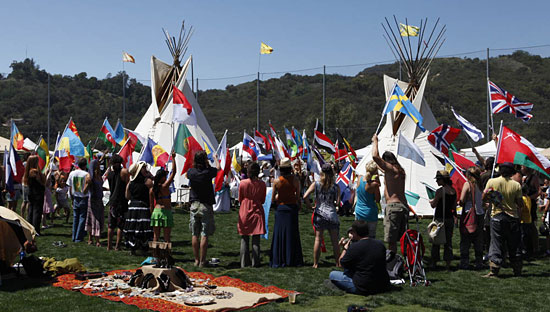
Topanga’s colorful Earth Day celebration includes a peace ceremony with flags from around the world.
Earth Day is upon us. Folks have been marking the occasion for a couple of weeks already, but this weekend is the real deal. Here are some of the options.
Saturday, April 20
- Los Angeles Waterkeeper will host its second annual Stand-Up for Clean Water Earth Day Festival and Paddleboard Race. There will be environmental speakers, races, stand-up paddleboard demonstrations, lessons and a beach cleanup, all at the historic Annenberg Community Beach House in Santa Monica.
- In the South Bay, Earth Day Bird Fest is asking volunteers to help clean up Cabrillo Beach in the morning, and then experts will lay down some science about the coastal environment and its inhabitants. Food and live music will round out the event.
- At the Mar Vista Green Gardening Showcase, you can check out one community’s approach to urban environmentalism. Tour drought-resistant landscaping, aquaponic farming and native plant gardens—then learn how to create them in your own neck of the woods.
Sunday, April 21
- Children’s Earth Day plants the seed of stewardship in the next generation of environmental caretakers, activists and leaders of L.A. There will be crafts, games, a recycling maze, live entertainment and over 200 exotic rescue animals—all part of a schedule designed specifically for young eco-warriors.
- Tree huggers unite at LACMA’s Earth Day Tree Walk. Learn about the diverse trees of Hancock Park with botanist Matt Ritter, who will sign copies of his new book, A Californian’s Guide to the Trees Among Us, following the tour.
All weekend
- Heal the Bay’s education-focused Earth Day Festival takes place Saturday, April 20, and Sunday, April 21. In addition to family-oriented fare at the Santa Monica Pier Aquarium, participants can check out the BlueGreen Beach Sweep and Deck Party, which includes a conservation-minded swap party and an Eco Beer Crawl. Volunteers who participate in a Saturday morning beach cleanup receive free admission to the aquarium.
- Downtown at the Los Angeles State Historic Park on Saturday, April 20, Earth Day Latino will feature green career exhibitions, drum circles, healthy food, bicycle safety check-ups and an overnight urban campout that will merge into CicLAvia’s car-free street fest on Sunday, April 21.
- Topanga Earth Day takes place Saturday and Sunday, too. The theme this year is “Awakening Essence,” so there will be a variety of healthy programming—including yoga, vegan foods and dancing—to nourish body and soul. Several stages of live music will provide the soundscape in the scenic canyon.
Posted 4/16/13
No deficit of good news in this budget
April 15, 2013
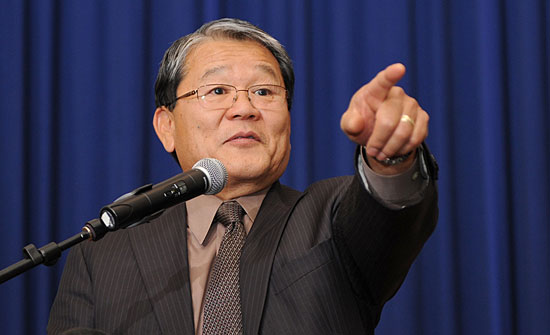
Chief Executive Officer William T Fujioka says his budget proposal reflects years of fiscal discipline in the county.
Just three years ago, in the thick of the Great Recession, Los Angeles County officials proposed a budget to the Board of Supervisors with a deficit of more than $490 million, prompting an extraordinary belt-tightening that forced some county departments to slash spending by more than 30 percent.
Back then, Chief Executive Officer William T Fujioka put the best spin possible on the gloomy situation. Despite the gaping shortfall, he said, the county had not been forced to significantly reduce services or lay off workers, who’ d agreed to forgo raises until the crisis had passed.
It looks like that day may have come.
On Monday, CEO Fujioka offered a $24.7 billion spending plan for board approval that, for the first time in five years, has no deficit and no proposed cuts. This year, there’ll be no raiding reserves or other one-time funding solutions.
“This is unheard of, not only here within the county but throughout the state of California,” Fujioka said of the county’s proposed zero-deficit budget, which will be financed entirely by ongoing revenue sources. Departmental cutbacks, efficiency initiatives and rising property and sales tax revenues were central to the budget turnaround, Fujioka said. But the county could not have weathered the economic storm, he stressed, without the fiscal discipline of the Board of Supervisors and the cooperation of employee unions.
Unlike City of Los Angeles workers, whose raises have been blamed for the city’s dire finances, county workers haven’t received a cost-of-living raise in five years—a savings of hundreds of millions of dollars that has helped preserve programs and save jobs. The unions agreed to the arrangement so long as the money would begin to flow once the county’s finances were back on track. Union leaders are wasting no time holding the county to its word; Fujioka said his office already has begun negotiating with public safety unions.
Jim Adams of the CEO’s office, who’s been negotiating with the unions for a little more than a month, says he expects there’ll be “some kind of pay increase.” Citing the confidentiality of the talks, he declined to be more specific but cautioned that every 1-percent increase in the county workforce’s payroll amounts to close to $40 million, not including benefits. “We’ll be sweeping the budget corners,” looking for ways to fund raises, he said.
Adams and others said they expect a chunk of that to come from rising property tax revenues, which are likely to exceed the Assessor’s conservative forecast of 2.88 percent for fiscal year 2013-2014.
For the most part, the new spending plan holds the line on departmental budgets that have been pared back during the past five years, recommending only small spending increases or none at all. “We’re not going to quickly and blindly restore people” to departments without a specific need, Fujioka said during a morning news conference. He cited, for example, a reduction in the number of clerical workers in the treasurer’s office to process property tax payments. As a result, the payments took an extra day or two to deposit in the bank, Fujioka said, costing the county “a lot of money” in interest.
The CEO says he is, however, recommending that new funding be used to enact a series of reforms urged last year by the Citizens’ Commission on Jail Violence, which investigated alleged deputy brutality within the county’s lockup. Among other things, Fujioka said he’s proposing that $5 million be set aside each year for the soon-to-be-created Office of the Inspector General, which will oversee and monitor sheriff operations in the jail and on the streets.
Fujioka also cautioned that unforeseen budget pressures could arise from the full implementation next year of the Affordable Care Act, as well as the continuing implementation of a massive transfer of responsibilities from the state to the county for supervision of ex-California prison inmates.
Still, despite such uncertainties, Fujioka’s press briefing had the feel of a victory lap as he praised the leadership shown by the five members of the Board of Supervisors, who’ll begin public hearings on the budget in May.
“You probably think it’s easy for a guy like me to say something like that because they’re the people I work for,” Fujioka said. “But it’s the absolute truth.”
(For a quick-paced video primer on the county budget process, click here.)
Posted 4/15/13
Earth Day gets around
April 11, 2013
Earth Day is all over the map, and not just geographically-speaking. Throughout Los Angeles County, diverse groups are building traditions that shape the holiday—and help heal the planet—in a variety of ways.
In fact, Earth Day has gotten so big that the event can’t be limited to one day. The official observance is Monday, April 22, but events are spilling out across the calendar, with many starting this weekend.
Among those getting an early jump is the city of Calabasas, which is sponsoring its Earth Day Celebration/Green Expo on Saturday, April 13, from 2 p.m. to 5 p.m.
Tarzana is also an early bird, with Earth Day festivities this Saturday, April 13, that include a free pancake breakfast, an obstacle course, a poster-making contest and other family-oriented fare.
Volunteers can get their hands dirty working on a restoration and cleanup at Malibu Creek State Park on Saturday, April 13. Jerry Emory of the California State Parks Foundation, which is sponsoring the event, noted that such volunteerism helps chip away at $1.4 billion in deferred maintenance stemming from budgetary problems.
For professional environmentalists, Earth Day, regardless of where it falls on the calendar, is a chance to reach a broader audience.
“I think Earth Day is a way to connect people to the fact that this planet is fragile,” said Meredith McCarthy, director of programs for Heal the Bay. “It’s an opportunity, but it’s also scary because there is so much need to repair what has been done to this planet.”
Heal the Bay will host events throughout April to clean up beaches, creeks and neighborhoods. They’re also throwing a two-day educational festival at the Santa Monica Pier on April 20-21. Also on April 20, fellow water-protectors Los Angeles Waterkeeper will hold their second annual Stand-Up for Clean Water Earth Day Festival and Paddleboard Race to lure even more people to the beach.
Then there’s Earth Day Latino, from April 21 to April 22, which seeks to engage audiences with a mix of entertainment and conservation-minded fare.
Latino Earth Day aims to develop a community of new environmental stewards, said Antonio Gonzalez, president of the William C. Velázquez Institute. He and other producers of the event reached out to 10 high schools with an Eco-Intern program, where students performed tasks like analyzing water samples from the L.A. River.
“Our take is that we need to make it meaningful for a community that thought of it as a white, middle class thing,” Gonzalez said. “It’s our holiday, too. You have to promote that in a different way.”
In a class by itself is Topanga Canyon, where environmental consciousness is a way of life. Topanga Earth Day has everything from yoga and a peace ceremony to native planting workshops and dance activism, all set to live musical performances.
“We’re a living example of day-to-day respect and harmony with nature,” said Stephanie Lallouz, who has organized the event for the last 8 years. “We initiate that lifestyle and invite people from the city to see it.”
Posted 4/11/13
Taking a bite out of animal cruelty
April 11, 2013
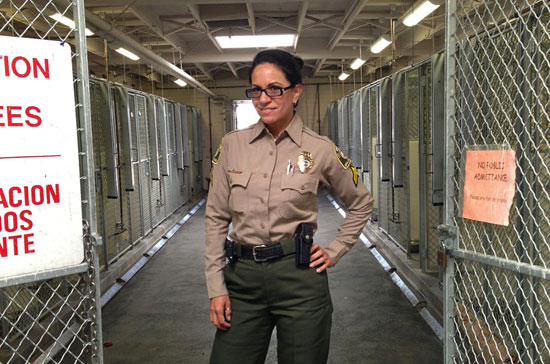
Abusers beware: Eva Montes and her crack team in the county animal control department are on the case.
What began 15 years ago simply as a promising job for a struggling single mom of three youngsters, has become a calling. “I am a voice for the animals,” says Eva Montes.
Those animals have come in all sizes and shapes, from furry to feathered, but they’ve suffered a common fate: they’ve been treated badly by people—sometimes through ignorance, sometimes with malice. And it’s not just about the animals.
“Most serial killers started with abusing animals,” Montes says, “and we have to put a stop to that early.”
Montes belongs to a select squad inside Los Angeles County’s Department of Animal Care & Control that investigates the agency’s most complex cases of animal neglect and cruelty. Called the Major Case Unit, its seven members tackle everything from highly organized pit bull and cockfighting rings to cat hoarders to single cases of heartbreaking—and criminal—abuse.
On Tuesday, she was among more than a dozen uniformed colleagues picked to represent the department before the Board of Supervisors as part of “Animal Control Officers Appreciation Week in Los Angeles County.” While the agency is best known for its shelter system and efforts to find adoptive homes for animals, the largely unsung detective work of its Major Case Unit, or MCU, is central to the agency’s mandate.
“By our very mission, we’re charged with protecting the public and protecting animals,” says Deputy Director Aaron Reyes, who oversees the unit. “One of the best ways we can do that is to investigate crimes of cruelty, abuse, neglect and illegal animal fighting.”
Reyes says the MCU was created more than a decade ago when it became clear that the massive volume of calls handled by animal control officers was preventing them from undertaking sustained and difficult investigations. Until last year, the MCU had been based in the original “pound master’s house” at the department’s first-ever facility, which opened in Downey in 1946. But Reyes says he thought it was crucial to get the team’s members “onto the front lines” and base them in various shelters, where they could initiate investigations more quickly and share their expertise and insights with other officers.
The idea to scatter the team was not met with enthusiasm.
“We were against it,” recalls Montes, who’s been in the unit for nearly three years. “We hung out together. We were family. But it’s worked out better.” Since being assigned to the Carson Animal Care Center, Montes says, she’s found potential abuse cases “that were slipping through the cracks” because some officers were not creative enough in their investigations or sufficiently trained to spot signs of less obvious abuse or neglect when people were bringing dogs to the shelter.
Since last July, Montes says she has, for the first time, initiated a number of investigations of people who’ve brought dogs to the facility, including a woman who recently turned in a pit bull that looked like it had been used for fighting. A warrant for her arrest was recently issued. Last November, Montes was instrumental in a joint investigation with the SPCA Los Angeles that led to a long list of cruelty charges filed by the district attorney’s office against the owner of a Gardena guard dog business.
Being assigned fulltime to the Carson shelter, which serves some of southern Los Angeles County’s most impoverished neighborhoods, has been a culture shock for Montes. Before her promotion to the MCU, she spent nine years in the county’s Agoura Animal Care Center, high in the mountains above Malibu. She calls it “the Club Med of shelters.” The dogs, she says, are mostly of the “frou-frou” variety, and volunteerism is robust, something for which she’ll always be grateful on a very personal level. During Montes’ tenure there, her 14-year-old daughter died from a form of bone cancer. Volunteers built a misting system to keep the animals cooler during the summer months and dedicated it with a plaque in honor of Montes’ daughter, Jessica.
“She really respected my job,” Montes says of her girl. “If she could only see me now.”
In contrast to the Agoura shelter, Montes’ current assignment has exposed her to some of the meanest dogs and toughest owners in the department’s jurisdiction, a swath of southern Los Angeles County where “gang members represent themselves with their dogs.” Sometimes, she says, packs of “dominant breed” dogs such as Rottweilers and pit bulls roam the streets. “It’s scary,” she says. “I worry about getting bit and never being able to work again.”
Montes says she’s received cooperation during her neighborhood investigations but has been told by some male officers that they’ve encountered resistance when responding to complaints, being warned: “Get off my property or I’ll shoot you.”
One of Montes’ colleagues in the Major Case Unit is Armando Ferrufino, who, like her, also works in the southern part of the county. An expert on cockfighting, he’s assigned to the Downey Animal Care Center. And like Montes, he also feels as though he’s a voice for the animals.
He tells the story of a man who, for months, allowed his Rottweiler, Duke, to deteriorate into a mass of tumors and sores, refusing to seek medical help despite the animal’s obvious suffering. Acting on a tip, animal control officers rescued Duke, but he was too far gone to save.
“I felt like the spirit of the animal was telling me to do the right thing, to investigate and get the whole truth,” Ferrufino says. “And I did.” The owner was charged with a felony and sentenced to three months in county jail.
Ferrufino, who joined the MCU in 2009, says one of the most sensitive assignments involves animal hoarders, mostly lonely elderly people whose homes are filled with scores of cats, a good number of them ailing. “In their mind,” Ferrufino says, “they believe they are doing the right thing—showing them love—but it gets to the point where they can’t take care of them.”
If the neglect is severe, he says, then charges are pursued. Authorities also provide referrals for counseling. What’s more, the county has a program to help clean homes after animals have been removed during often tearful negotiations with owners. “It’s an illness,” Ferrufino says. “They’re not aware they’re doing something wrong.”
As difficult and wrenching as the work can be, Ferrufino says, he’s found his calling, too.
“Every day I come to work, I’m happy,” he says. “You don’t know what’s going to happen next, from hoarders to horses to cockfights.”
Montes agrees. “Some people like to stay in the shelter environment. But I saw other officers out there getting justice and I said: ‘That’s what I want to do.’ “
Posted 4/12/13




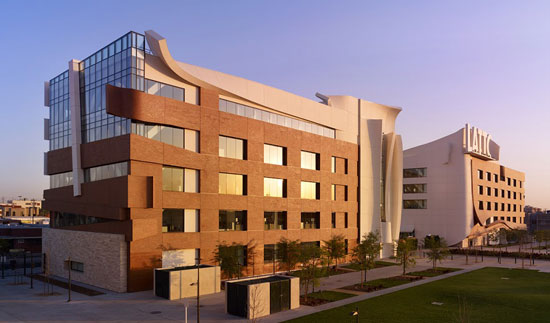
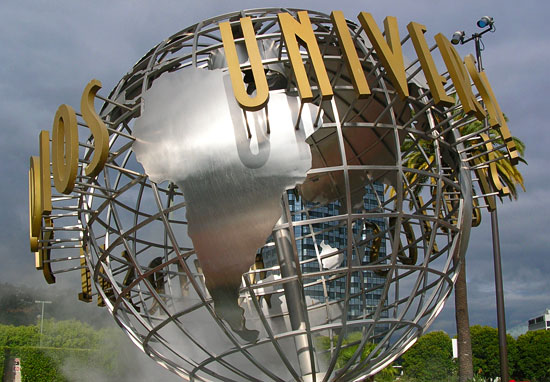
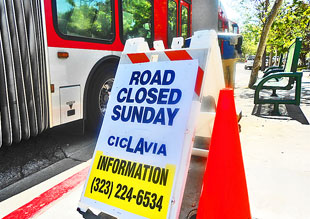

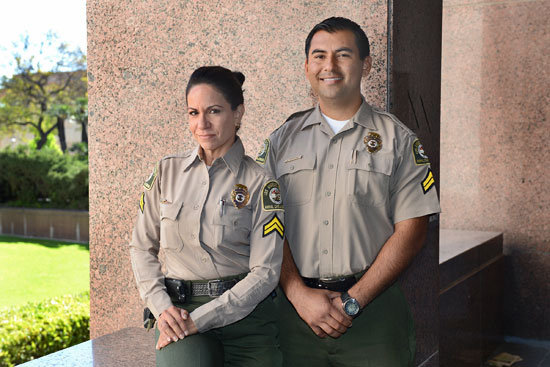





 Check for the latest closure information
Check for the latest closure information








